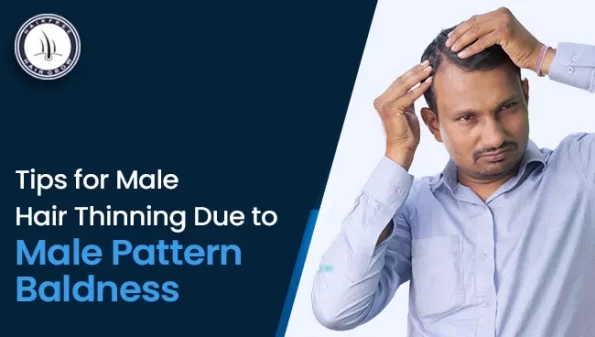Hair thinning is a common concern among men, particularly when it is attributed to male pattern baldness. While hair loss can be distressing, there are several steps you can take to manage and potentially slow down the progression of this condition. By understanding the causes and implementing certain lifestyle changes, you can improve the overall health of your hair and boost your self-confidence. In this article, we will explore effective tips to address male hair thinning due to male pattern baldness.
Understanding Male Pattern Baldness
Male pattern baldness, also known as androgenetic alopecia, is a genetic condition that affects the hair follicles. It is primarily caused by a combination of genetics and hormones, particularly dihydrotestosterone (DHT). Over time, DHT binds to hair follicles, causing them to shrink and produce thinner, shorter hair strands.
Causes of Hair Thinning in Male Pattern Baldness
Apart from genetics and hormones, several factors can exacerbate hair thinning in male pattern baldness. These include age, stress, poor nutrition, certain medications, and underlying health conditions. Identifying these causes can help you adopt targeted strategies to manage hair thinning effectively.
Recognizing the Early Signs of Hair Thinning
Early detection of hair thinning is crucial for implementing timely interventions. Keep an eye out for signs such as a receding hairline, thinning crown, or an increasing number of hairs in your comb or shower drain. Regularly monitoring your hair’s health allows for prompt action and potentially better results.
Maintaining a Healthy Lifestyle for Hair Health
A healthy lifestyle plays a significant role in promoting hair health. Ensure you consume a balanced diet rich in vitamins, minerals, and proteins. Regular exercise and sufficient sleep can also contribute to overall well-being, which indirectly affects the health of your hair.
Effective Hair Care Routine for Thinning Hair
Adopting an appropriate hair care routine is essential for managing hair thinning. Use gentle, sulfate-free shampoos and conditioners that nourish your scalp and hair. Avoid excessive heat styling and harsh chemicals that can further damage fragile hair strands. Additionally, consider incorporating scalp massages and low-level laser therapy into your routine to stimulate hair growth.
Choosing the Right Hairstyle and Products
Opting for the right hairstyle and hair products can make a significant difference in concealing hair thinning. Consult with a professional hairstylist who can recommend suitable cuts and styles that add volume and minimize the appearance of thinning areas. Furthermore, choose hair products specifically formulated for thinning hair, such as volumizing shampoos or styling sprays.
Seeking Professional Advice and Treatment Options
If you’re concerned about hair thinning, consulting with a hair loss specialist or dermatologist is highly recommended. They can assess your condition, provide accurate diagnoses, and recommend appropriate treatment options. These may include medications like minoxidil or finasteride, platelet-rich plasma(PRP) therapy, or hair transplantation.
Embracing Self-Confidence and Acceptance
It’s important to remember that hair thinning does not define your worth or attractiveness. Embrace self-confidence and acceptance of your appearance, knowing that baldness can be a natural part of life for many men. Focus on your positive attributes and engage in activities that boost your self-esteem.
Tips for Hair Thinning Due to Male Pattern Baldness
1. Embrace a Balanced Diet
A nutritious diet plays a crucial role in maintaining healthy hair. Include foods rich in vitamins, minerals, and proteins to support hair growth. Incorporate lean meats, fish, eggs, nuts, seeds, fruits, and vegetables into your meals. These provide essential nutrients such as biotin, zinc, iron, and omega-3 fatty acids that contribute to healthy hair follicles.
2. Stay Hydrated
Proper hydration is essential for overall health, including hair health. Drink an adequate amount of water daily to keep your body and scalp hydrated. Well-hydrated hair follicles are less prone to damage and breakage, promoting healthier hair growth.
3. Protect Your Hair from Heat and Chemicals
Excessive heat from styling tools and harsh chemicals in hair products can cause damage and lead to hair thinning. Limit the use of heat styling tools, and when you do use them, always apply a heat protectant. Choose hair products that are gentle and free from sulfates and parabens. Opt for natural or organic options whenever possible.
4. Practice Gentle Hair Care
Be gentle with your hair to avoid unnecessary breakage and hair loss. Avoid vigorous towel-drying and instead, pat your hair dry gently. Use a wide-toothed comb or a brush with soft bristles to detangle your hair, starting from the ends and gradually moving upwards. Avoid pulling or tugging on knots, as this can cause hair breakage.
5. Massage Your Scalp
Massaging your scalp regularly can stimulate blood circulation and promote hair growth. Use your fingertips to massage your scalp in circular motions for a few minutes each day. This simple technique helps nourish hair follicles and encourages the growth of healthy, thick hair.
6. Consider Hair Growth Supplements
Certain supplements can help support hair growth and combat hair thinning. Consult with a healthcare professional or a trichologist to determine if supplements such as biotin, vitamin D, or omega-3 fatty acids are suitable for you. Remember that supplements should complement a healthy diet, not replace it.
7. Avoid Hairstyles that Pull on the Hairline
Tight hairstyles, such as ponytails, buns, or braids that pull on the hairline, can contribute to hair thinning. Opt for looser hairstyles that do not exert excessive tension on your hair follicles. Consider using hair accessories that distribute the pressure evenly, such as scrunchies or fabric hair ties.
8. Manage Stress Levels
Stress can contribute to hair thinning, so it's important to find healthy ways to manage and reduce stress in your life. Engage in activities that help you relax and unwind, such as meditation, yoga, or spending time in nature. Prioritize self-care and make time for activities that bring you joy and peace.
9. Protect Your Scalp from the Sun
Excessive sun exposure can damage your hair and scalp, leading to hair thinning. Protect your scalp by wearing a hat or using a sunscreen specifically designed for the scalp. This precautionary measure not only protects your hair but also reduces the risk of sunburns and skin damage.
10. Consult a Professional
If you're experiencing significant hair thinning or have concerns about male pattern baldness, it is advisable to seek professional advice. Dermatologists and trichologists specialize in hair and scalp health and can provide personalized recommendations based on your specific condition. If you are looking for a professional hair transplant consultation you can come at Urban Clinic.
Urban Clinic is renowned for its expertise in hair transplant procedures. They have a team of experienced professionals who specialize in hair restoration and are dedicated to providing high-quality care to their patients.
Conclusion
Hair thinning due to male pattern baldness can be a challenging experience for many men. However, by understanding the causes and implementing effective strategies, it is possible to manage and potentially slow down hair loss. Adopting a healthy lifestyle, choosing the right hair care routine, seeking professional advice, and embracing self-confidence are key steps in addressing hair thinning. Remember, there are various options available to help you manage and cope with hair thinning, ensuring you feel comfortable and confident in your own skin.
Written By
MD (Skin & VD)
Dr. Kiran Chotaliya is a distinguished trichologist with over 10 years of experience, specializing in male pattern baldness. He has a deep understanding of the causes and treatments of male hair thinning. Dr. Chotaliya’s expertise lies in diagnosing this common condition and providing effective, personalized treatment plans.
Disclaimer
We’ve made all possible efforts to ensure that the information provided here is accurate, up-to-date and complete, however, it should not be treated as a substitute for professional medical advice, diagnosis or treatment. See Detailed Disclaimers Here.




